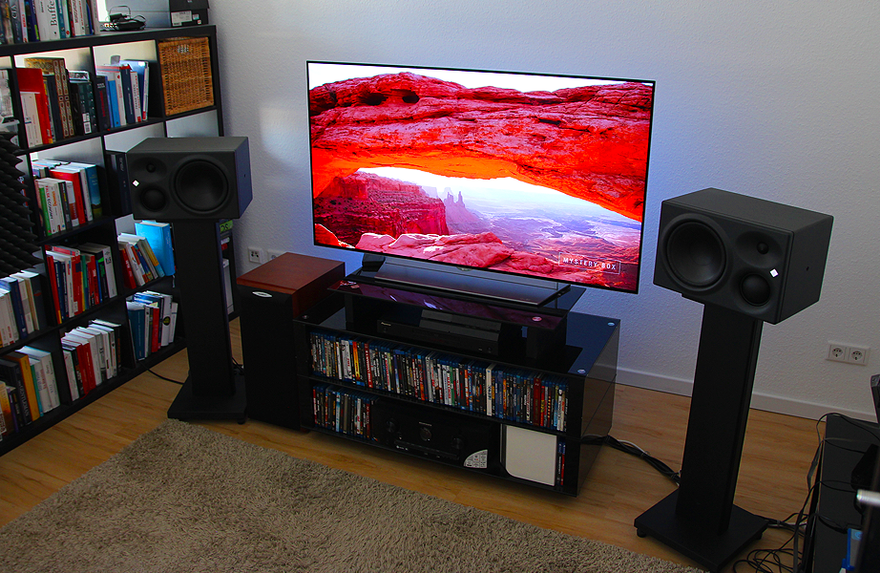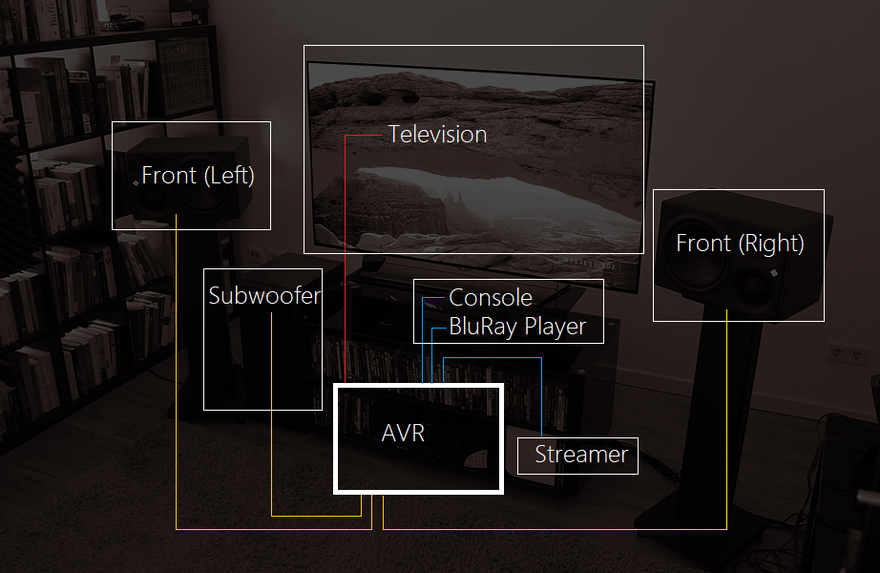2. Cinema management - www.hifilounge.eu
Main menu:
- Home
- General
-
Speakers
- Basics
- Speakers
- Headphones
- Subwoofer
- Elektronics
- Surround
- Photography
- Infos
2. Cinema management
Surround
A modern home cinema system can/should include several points.
- The connection and integration of all connected speakers.
- The television/beamer integrated as the central visual medium.
- The integration of streaming services like Netflix.
- Integration of gaming consoles, BluRay Players, etc.
- Streaming music from Spotify, Amazon or your own offline music collection.
- Easy to use.
- Good quality of sound and picture.
- Below you will a system with those features.

Figure 1: A Homecinema
The heart of the device is an audio video receiver (=AVR).
This device has the task
- To distribute the music signals from several sources to the speakers with high quality.
- To bring the picture e.g. from the BluRay Player to the TV.
Do do its job the AVR can have several features.
- It has built-in amplifiers so you can connect passive speakers.
- It has pre-outs to connect active speakers like done in the picture above.
- It has an output for headphones.
- It has built-in sound/image decoders to decode different image and sound formats from external devices.
- It can upscale incoming music signals to stereo or surround.
- It can filter the bass signals from the music signal and bring them to the subwoofer.
- It has a streaming options and a built-in radio.
- It has a room calibration function for the speakers.
- It has various inputs for external source devices such as HDMI.
- You can directly stream music and videos from your Smartphone via Bluetooth, Apple Airplay, etc.

Figure 2: Connections of this homecinema
With modern setups all sources and TVs are connected via HDMI. Passive Speakers are connected via speaker wire, active speakers via XLR. That means: You will only need two kinds of cables for modern cinemas. This is a big step up from the early years of Surround.
With stereo amplifiers the stereo full amplifier often takes over the task of the AVR. However, this usually has almost no equipment - neither Internet radio, room calibration nor HDMI. On the other hand, it usually provides better signal quality in the signal amplification for the stereo amplifier.
In practice this advantage is insignificant, in blind tests good AVRs cannot be distinguished from good stereo full amplifiers. For this purpose, several publicly organized blind tests by loudspeaker developer and former shop owner David Messinger from Vienna are recommended, the results were published on http://www.hififorum.at/ (German language)
- Direct link to the test from 15.10.2006: http://www.hififorum.at/forum/showthread.php?t=688
- Direct link to the test from 02.12.2007: http://www.hififorum.at/forum/showthread.php?t=2141
- Direct link to the test from 05.04.2009: http://www.hififorum.at/forum/showthread.php?t=4482
The entry level AVR Sony STR-DE85 could not be distinguished from a much more expensive ASR Emitter Exclusive Version Blue in these tests, comparisons with other AVRs and integrated amplifiers were similar. Only some tube amplifiers with strong inherent sound were recognizable as such. After the tests David used the signature in his forum:
A good AV receiver costs about 350-500€, depending on the desired equipment. If you take an examplar with pre-outs, active speakers can also be connected. This makes more sense than the purchase of an AV preamplifier, here the starting prices are about 1500€.
You will also find cheap surroundsystems where the AVR-functions are build into the Subwoofer. I prefer a solution with AVR.
Room calibration
The AVR's room calibration is done via a supplied microphone, the setup is usually done conveniently via a smartphone app or the TV display. Used correctly, this can improve the sound of the system - which means that AVRs can even win over puristic integrated amplifiers in terms of sound quality. But you should not expect miracles here. Main advantages of room calibration
The volume levels of the loudspeakers (including subwoofer) are set correctly relative to each other. Especially with the subwoofer this is difficult by hand.
If the installation/acoustics are very poor, the calibration can limit damage.
If the speakers are set up well, the calibration should not interfere with the mid-high range, since direct and diffuse sound is heard separately from the ear. If you bend the frequency response of one, you unfortunately bend the other.
In the low frequencies (below the so-called Schrödinger frequency) it makes sense to interfere with the frequency response of the loudspeakers, here the ear cannot distinguish between direct and diffuse sound. At low frequencies in many rooms room modes cause acoustically induced booming sounds. Room measurement can work wonders here. However, only drone maxima should be lowered, if minima in the frequency response are raised it can worsen the bass.
Decoder
In stereo, there is not much going on in the preamp, in an extremely puristic form a single potentiometer would be enough. In a surround system, the preamplifier is a core part of the system, the data sheet offers plenty of abbreviations - the most common words are mentioned here:
Dolby-Pro-Logic : The good old CD has only 2 channels. But a 5.1 home cinema has 5+1=6 speakers. The simplest approach is to use only 2 of the speakers, but there are also upmix procedures on surround. The AV receiver that masters this method can use an (analog) decoder to place the amplitude and phase content of the stereo channels on the center, while the rear speakers are also given offshoots of the two audio tracks in Dolby Pro-Logic and Dolby Surround, but with deliberately built in phase "errors" and only play from 100 to 7000 Hz. Then the whole thing is spiced up with artificial reverb. This pepping up works theoretically with every stereo recording.
A separate LFE (Low Frequency Effects) track for the subwoofer is also not included, it is created by screening out normal crossovers in the AV receiver.
If you take into account later "pepping up" by the decoder already during recording, the effect can really convince. Even the good old video cassette with corresponding "preparations" could contain surround effects with only 2 sound tracks.
On a stereo system, where the channels are output in stereo, the result hardly sounds worse than a normal stereo recording, since the extended phase-shifted content contributes to the spatiality of the film. With a surround system, the recording is naturally in its element.
The upmix also works quite well with music, but many find this pseudo-spatiality unnatural. Accordingly mixed movies do better here.
Dolby Surround: The predecessor of Dolby Pro-Logic. No support for centre speakers, the rear channels are inserted comparatively uncleanly into the sound, the channel separation is audibly better with Pro-Logic.
Dolby Digital: Also known as AC-3, also from Dolby The usual sound format on the DVD. In contrast to the 2-channel upmix of Dolby Pro Logic, all channels are stored separately. The number of channels is also indicated. Dolby Digital 5.1 would therefore offer 5+1=6 separate (=discrete) separately stored mono sound tracks. Normally 5.1 sound is stored at 384 or 448 kbps, the compression may remind some people of formats like MP3.
In contrast to the upmix formats, Dolby Digital DVDs cannot be played on stereo systems without problems. With AC-3 DVDs there must be a (digital) decoder (sound card, DVD player or receiver) for this format somewhere. Most DVDs that have Dolby Digital audio tracks have additional stereo audio tracks, so there is no reason to worry.
DTS (digital theater sound)l: A competing development to Dolby from the direction of Steven Spielberg. DTS also works with separately stored channels. The difference lies in the lower compression. Picture and sound are synchronized because of a common track.
THX (Tomlinson Holman's Experiments) THX EX, THX Ultra and THX Ultra II are prestigious seals of approval from Lucasfilm. The driving force is George Lucas, who is not entirely unknown as the director of Star Wars. There are specifications for the different strict THX versions regarding radiation characteristics, level stability, whether dipoles should be used on the back... At least some of the specifications are somewhat controversial in professional circles - as well as the question whether THX is more in the direction of "seal of approval" or "prestigious".
There are also THX certified films. These can be played on the usual Dolby Digital or DTS systems.
The successor of the DVD is the BluRay disc. Of course, higher resolution formats are also used, including: Dolby Digital Plus, Dolby True HD, DTS HD, DTS HD Master. Whether the new formats really do offer much more in terms of sound than DTS is not to be discussed here.
Dolby Atmos: Dolby Atmos theoretically allows an unlimited number of audio tracks. Strictly speaking, these are sound objects that can be positioned at specific coordinates in the listening room. The first generation of hardware, the Dolby Atmos Cinema Processor, supports up to 128 individual sound tracks and up to 64 separate output signals. By not having audio tracks for 5.1 or 7.1 and directly saving the location of phantom sources this technology allows a better downscaling on several setups: From Stereo, 4.0 or 7.1. You can even mount speakers above your listening position.
Music and Surround
Actually, surround sound has established itself rather with home cinema freaks and gamers. Listening to music in surround is still not that common - even though trance or classical music can sound impressive on a good surround system.
- Music CDs, MP3s and vynil have only two (=stereo) audio tracks. Here you can either use 2 speakers or try one of the upmix variants of your AVR. Thats not the perfect surround experience, but the result can be quite fun.
- A real progress are SACD and DVD Audio records, which have the surround sound tracks discretely (separately) stored. This is "real" surround.
The SACD (Super Audio CD) is a pure data carrier for music. A high-quality 1-bit Delta Sigma analog/digital converter with a sampling frequency of 2.8224 MHz is used in the production. The music is served with 120 db dynamic range and an upper cut-off frequency of 100 khz. As a comparison, the CD only comes up to 20 khz, 44.1 khz sampling rate and has a ridiculous 90db dynamic range.
The various channels clearly speak in favour of SACD. Some mediocre recordings only offer additional clapping sounds from behind - some recordings, however, are a real experience on a worthy system.
There are different SACDs. Hybrid SACDs are actually the most convenient. These have an additional stereo sound track for normal CD players. The SACD content is scanned by a (DVD-) laser with 658nm, and lies over a normal CD track. The SACD track is invisible to the CD laser, which scans at 780 nm wavelength.
DVD Audio is a direct competitor. 144 db dynamic range, 96 khz. For stereo there is a choice between 44.1 / 48 / 88.2 / 96 / 176.4 / 192 kHz and for multi-channel 44.1 / 48 / 88.2 / 96 kHz. Probably more interesting in practice: the DVD also offers still images. Moving pictures are not provided. Hybrids, which can also be played on CD players, are also in circulation.
Neither SACD nor DVD Audio have established themselves strongly on the market so far, and thanks to the new Blue Ray DVD, there are rumours of successors.
Streaming services with surround could be a great next step. Tidal and Amazon Music HD are streaming Songs in Dolby Atmos... that could be a gamechanger and finally establish the acceptance of surround not only for movies but also for music.